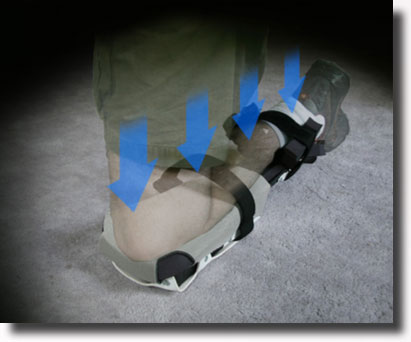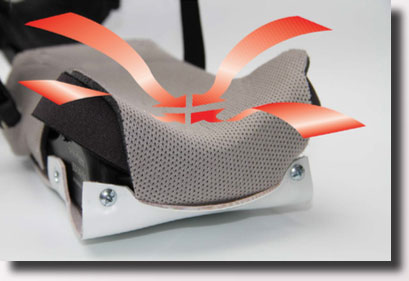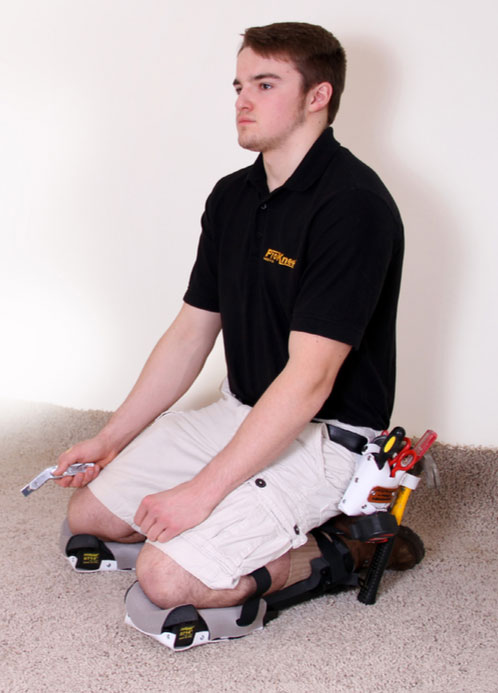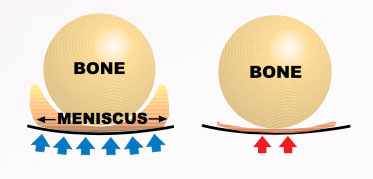The Ergonomics of Kneeling
An opinion by Lee Richards, President of ProKnee Corporation, est. 1989.
The information herein was compiled by Lee from a two year study of
occupations, including all types of flooring installation, construction
(commercial & residential), industrial metal fabrication and textile
manufacturing. Lee has consulted and conferred with many safety
engineers and health experts in the rehabilitation and prevention of
occupational knee injuries.
Several insurance companies, across the
United States, process orders through ProKnee for claims growing from
occupational knee injuries.
After studying the various kneeling positions and injuries of people that work on their knees, several observations have been made:
1) People who have sore knees often have sore backs. Why? When people
are tired and sore from kneeling they often compensate by stooping
over. This causes the weight of the upper body to transfer off the knees
and onto the lower back area.
This leads to excessive fatigue, chronic pain and injuries to the muscles and vertebra of the lower back.
2) When the weight of a person is concentrated to the knee area, there is friction between the bones at the joint. Sandwiched between the bones lies a thin layer of cartilage and tissue (meniscus), that acts as a cushion, which allows pain free movement of the joint. With not much natural support to hold it together, the joint continuously works on this thin layer until it starts to wear out. This may cause an assortment of knee problems including loose joints, knee burn pain, and fluid build up and tissue swelling.
3) Another typical kneeling position is sitting back on your calf muscles with the tops of your feet flattened against the floor.
The drawback is that the ligaments and muscles on the top of the foot can over stretch, causing pain and cramping that can make it difficult to walk or run after a full day’s work.
4) Another popular belief is, when a carpet installer kicks a knee kicker, the force of the thigh against the pad on the knee kicker is the damaging factor. The real stress from kicking is, when the thigh strikes the knee kicker, the weight of the whole body is multiplied and then transferred straight down. This super compresses the thin layer of cartilage and meniscus located in the knee joint area, thus causing the assortment of knee problems mentioned above. Add to that all of the turning and twisting that takes place while walking around on your knees and you can see why so much damage can occur.
All of the kneepads on today’s market are beneficial to the user.
It
is left up to the individual to decide what his or her level of comfort
is. As their level of comfort changes, you will see them go from not
using knee pads at all to something that gets that level of comfort
back, thus the multitude of knee pads available.
You may also notice the change in complexity of the design. Example, foam cushions with straps located behind the knee joints up through to a fully engineered kneeling device.
At ProKnee Corp, we understand the ergonomics of kneeling and have set very high standards of function that must be included into a high performance kneepad. ProKnee’s design promotes proper kneeling technique, forcing the knees to respond to the therapy that the kneepads create. The first thing we do is surround the knee joint area with a knee cup shape, which holds the joint tight as you kneel. Next we take the weight off the joints by spreading it out over the length of the shins. Example, a 200 lbs. person 5’10” tall, would be calculated like this, 200 lbs. divided by 2 legs = 100 lbs., divided by the length of the kneeling area, 17″ = 5.88 lbs. per lineal inch +/-, per knee joint.
Being custom fit, the knee pads ride off the tops of your feet which, allows us to locate the top straps approximately 3″ below the knee joints. This eliminates pinching and binding that can cause circulation problems to your lower legs.
Balancing your body weight across the shins creates a mechanism, which does not allow over stretching of the ligaments and muscles of your feet, when sitting back on your calf muscles. Another important consideration is the material that’s used for the cushion. ProKnee uses a combination of super resilient, soft, cellular urethane backed up by a thinner layer of high-density cellular urethane. This takes the shock out of the day to day kneeling.




